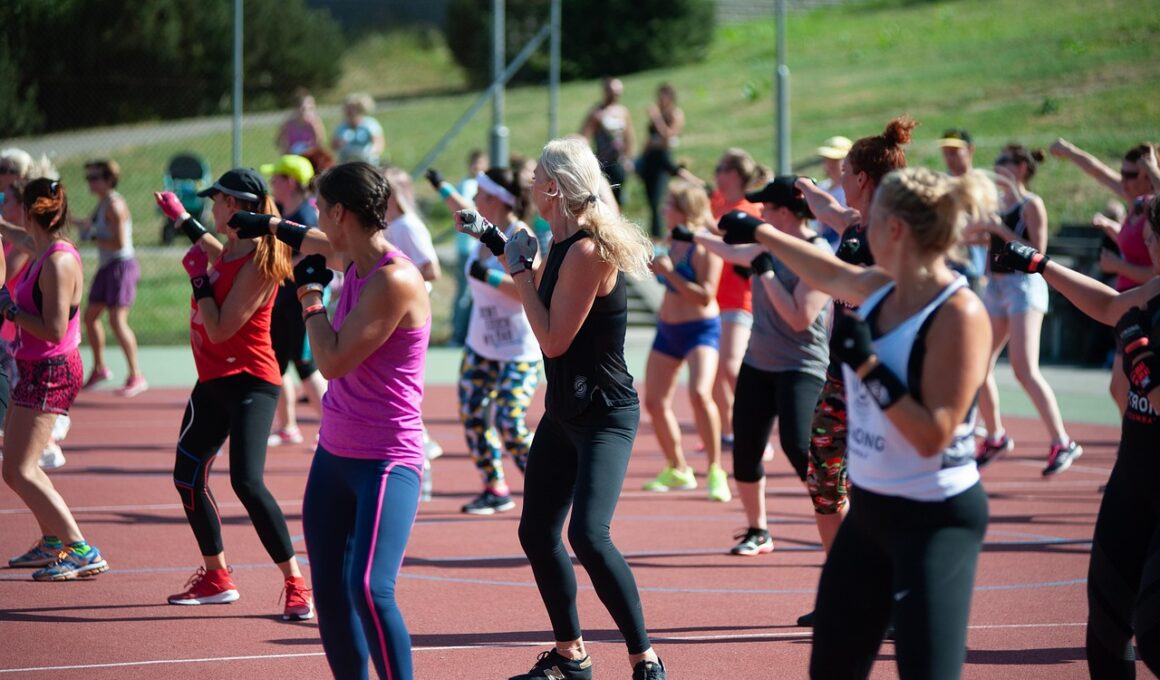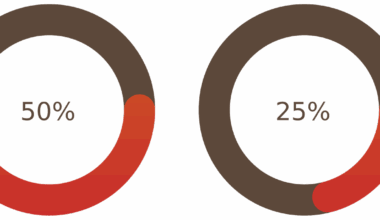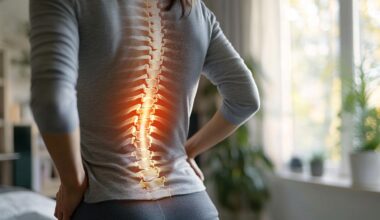Nutrition Tips to Support High-Intensity Dance Fitness Training
High-intensity dance workouts demand a lot from your body. Correct nutrition is essential to fuel your energy levels and enhance performance. Start by consuming plenty of carbohydrates to replenish glycogen stores. Healthy options include whole grains, fruits, and starchy vegetables. Proteins are crucial for muscle recovery, so include lean meats, legumes, and dairy in your meals. Don’t forget about healthy fats, which provide essential fatty acids for sustained energy. Incorporate foods rich in omega-3 fatty acids, like salmon and flaxseeds, to support your heart health. Hydration plays a significant role as well; drink plenty of water before, during, and after workouts to avoid dehydration. If you’re sweating heavily, consider an electrolyte drink to replace lost minerals. Timing is vital, too; aim to eat a balanced meal 2-3 hours before your workout. Consider a light snack closer to your workout that includes carbs and some protein. Lastly, listen to your body. If you feel fatigued or sluggish, assess your nutrition and make adjustments as needed. Your body’s signals are vital in ensuring you stay on top of your game.
Pre-Workout Nutrition
Before engaging in high-intensity dance workouts, it’s essential to have a pre-workout nutrition strategy. Your body requires fuel to maximize performance and endurance during strenuous activities. Ideally, consume a balanced meal containing complex carbohydrates and protein around 2-3 hours prior to your session. Foods like oatmeal with blueberries or a whole-grain sandwich with lean turkey can work wonders. If you’re short on time, a light snack 30-60 minutes before exercising can help. Opt for simple carbohydrates that digest quickly, such as a banana, an apple, or a small yogurt. Avoid heavy, fatty foods right before your workout as they may cause discomfort and sluggishness. Hydration should also be a priority, so drink plenty of water beforehand. If engaging in a longer dance session, consider preparing a small snack for post-workout energy replenishment as well. Remember, the goal is to provide your muscles with immediate energy sources while also protecting your body from fatigue. Adopting a structured pre-workout nutrition routine can significantly improve your overall performance.
After your dance workout, your body enters a critical recovery phase that’s essential for restoring energy and repairing muscles. Post-workout nutrition should focus on replenishing glycogen stores and providing proteins for muscle repair. A meal combining protein and carbohydrates should be consumed within 30 to 60 minutes post-exercise. Smoothies with fruits and protein powder can be a convenient option. Greek yogurt topped with fruit and honey or a whole-grain wrap with chicken are also great alternatives. Hydration is equally essential in this phase; replenishing fluids lost through sweat ensures proper recovery. Including recovery foods rich in vitamins and minerals helps your body heal. Consider incorporating leafy greens, berries, and nuts into your meals, as they provide essential antioxidants. Again, listen to your body. Depending on the intensity of your workout, adjust portion sizes accordingly. Skipping this step can hinder your progress and lead to excessive fatigue or overtraining. By ensuring proper post-workout nutrition, you will facilitate better recovery and maintain your energy levels for future high-intensity dance fitness sessions.
Daily Nutrition Guidelines
For optimal performance in high-intensity dance workouts, daily nutrition guidelines should be followed to ensure you’re always ready to move. Aim to consume a balanced diet rich in vitamins, minerals, and macronutrients. Hydration is key; always have water accessible throughout the day. Integrate seasonal fruits and vegetables at every meal to ensure a colorful plate full of antioxidants. Lean proteins such as fish, chicken, or plant-based options like legumes are essential for muscle repair. Adequate fat intake, including avocados, nuts, and olive oil, supports energy levels during intense sessions. You should also consider meal prepping to keep your nutrition on track. Having healthy meals ready helps avoid impulsive, less nutritious choices. Consider dividing your meals into smaller, frequent portions instead of three large ones. This approach can sustain energy levels and improve digestion. Don’t forget to treat yourself occasionally; enjoying your favorite foods in moderation can have a positive effect on your mindset. Balanced nutrition paired with self-care leads to maximum enjoyment and performance during high-energy dance workouts.
Supplementation can play a role in supporting your nutrition for high-intensity dance fitness. While whole foods should be your primary source of nutrients, specific supplements may offer benefits. For instance, protein powders can help meet protein requirements, especially for those with busy schedules. Creatine may aid in boosting energy during high-intensity efforts, while branched-chain amino acids (BCAAs) can help decrease muscle soreness post-workout. Additionally, omega-3 supplements can be beneficial for inflammation reduction. Always consult with a healthcare provider before introducing new supplements to ensure they align with your goals and needs. Be mindful of choosing quality supplements that undergo third-party testing to ensure safety and efficacy. Proper dosages should be adhered to, avoiding the temptation to exceed recommendations. Vitamins and minerals, like magnesium and vitamin D, can also be supportive, particularly if you have dietary restrictions. However, focus primarily on obtaining nutrients from a varied diet first. With the right combination of foods, hydration, and supplements, great progress can be made in high-intensity dance training. Always evaluate your body’s response to supplements for best results.
Mental Aspects of Nutrition
Nutrition isn’t just about what you eat; it also plays a significant role in mental well-being, which is essential in high-intensity dance fitness. Eating a balanced diet can positively affect your mood, energy levels, and motivation. Focus on including foods that promote brain health, such as fatty fish rich in omega-3s, fruits, and vegetables high in antioxidants. Mindful eating is another aspect to consider; taking the time to appreciate your food helps develop a positive relationship with it. Being present during meals can reduce stress and improve digestion. Setting meal times can serve as a ritual to create structure in your day, which can benefit mental clarity. If you find yourself struggling with motivation, consider tweaking your nutrition habits. A nutritious snack can be the energy boost needed to lace up your shoes. Social interactions during meals can enhance enjoyment; consider inviting friends to prepare healthy dishes or share meals together. Mental health and nutrition are interconnected, so prioritize both aspects to support your high-energy dance fitness journey. Remember, balance is vital, and enjoyment shouldn’t be sacrificed.
In conclusion, proper nutrition is foundational for anyone engaging in high-intensity dance workouts. It not only fuels performance but also promotes recovery and enhances overall health. Establishing routine eating patterns that prioritize whole foods will provide the essential nutrients your body craves. Pay attention to hydration, carbohydrate, protein, and fat intake before and after workouts to maximize benefits. Do not underestimate the importance of timing your meals, as this can significantly influence your energy levels during sessions. Remember, there is no one-size-fits-all solution; listen to your body’s needs and adjust your diet accordingly. Consistent evaluation of your nutrition habits allows for adjustments that can further enhance your performance. Embrace healthy meal options, maintain a positive mindset, and treat yourself occasionally to ensure sustainability. This approach fosters a stronger connection between your overall lifestyle and fitness aspirations. With mindful nutrition practices in place, you will not only excel in your dance fitness journey but also enjoy the process immensely. Commit to continuous learning about your nutritional needs and stay flexible with your dietary choices as you progress.
By implementing the tips shared in this article, you can support your high-intensity dance fitness training effectively. Fuel your body with the right nutrients, ensure proper hydration, and listen to your needs consistently to maintain peak performance and survive even the most challenging workouts. Each element plays a role in shaping your overall experience and success. Start today by assessing your current nutrition practices and making necessary adjustments for maximum benefit. Consider consulting with a nutritionist or fitness professional if you feel uncertain about your dietary choices. Their guidance can provide clarity and assist you in developing a tailored plan. Engage in discussions about nutrition with fellow dancers to share ideas and inspiration. Food can be an exciting part of your training, enriching your journey with flavors and culture. Remember that recovery is just as important as your nutrition; treat your body with respect and care to avoid burnout. Focus on balance, enjoyment, and health overall. Embrace the lifestyle changes, and enjoy every moment of your high-energy dance fitness experience.


